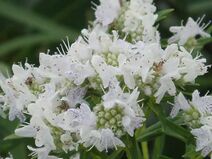Pycnanthemum virginianum
| Pycnanthemum virginianum | |
 | |
| Light: | |
| Moisture: | |
| Hardiness: | 5 |
| Soil pH: | 5.6-8.4 |
| Height: | 3' |
| Blooms: | Late Summer-Early Fall |
| Native to: | |
| Nectary | |
| Edible Rating: | |
| Medicinal Rating: | |
| Tea: | Yes |
Pycnanthemum virginianum (common name: Virginia mountain mint)
Propagation: Seed - sow spring or autumn in a cold frame. When they are large enough to handle, prick the seedlings out into individual pots and plant them out in the summer.
If there are sufficient seeds they can be sown in an outdoor seedbed in April.
Division in spring.
Cultivation: Succeeds in most soils[1] but prefers a rich loamy soil in full sun or partial shade with plenty of moisture in the growing season[2].
Plants are hardy to at least -15°c[3].
Range: Eastern N. America - Virginia to New England, north to North Dakota.
Habitat: Gravelly shores, meadows, dry to wet thickets etc[4].
Edibility: Flower buds and leaves - raw or cooked. A mint-like flavour, they make a nice addition to salads or can be used as a condiment[5][6][7][3].
The fresh or dried leaves are brewed into a refreshing mint-like tea[7].
Medicinal: A tea made from the leaves is alterative, diaphoretic and carminative[8][9]. A poultice of the leaves is used in the treatment of headaches[8]. The tea is also used in the treatment of menstrual disorders, indigestion, colic, coughs, colds, chills and fevers[8][3][9].The flowering stems are cut as flowering begins and they can be used fresh or dried[3]. There is a suggestion that this plant can cause abortions, so it is best not used by pregnant women[9].
Pollinators: Insects
Soil: Can grow in light, medium, and heavy soils.
Flower Type: Hermaphrodite
Also Known As: Koellia virginiana.
Links
References
- ↑ Chittendon, Fred. RHS Dictionary of Plants. Oxford University Press, 1951.
- ↑ Huxley, Anthony. The New Royal Horticultural Society Dictionary of Gardening. MacMillan Press, 1992.
- ↑ 3.0 3.1 3.2 3.3 Bown, Deni. Royal Horticultural Society Encyclopaedia of Herbs and Their Uses. Dorling Kindersley, 1995.
- ↑ Lyndon, Merritt. Gray's Manual of Botany. American Book Co, 1950.
- ↑ Usher, George. A Dictionary of Plants Used by Man. Constable, 1974.
- ↑ Yanovsky, Elias. Food Plants of the North American Indians Publication 237. US Department of Agriculture.
- ↑ 7.0 7.1 Facciola, Stephen. Cornucopia - A Source Book of Edible Plants. Kampong Publications, 1990.
- ↑ 8.0 8.1 8.2 Foster, Steven and Billy Tatum. Medicinal Plants of Eastern and Central North America. Houghton Mifflin, 1990.
- ↑ 9.0 9.1 9.2 Moerman, Daniel. Native American Ethnobotany. Timber Press, 1998.